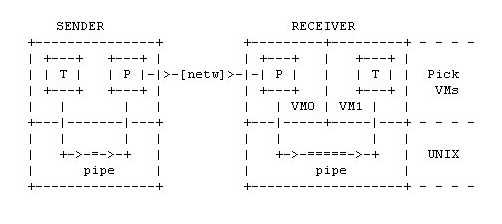Network save/restore
This topic describes how to implement a full save/restore of one machine to another across a network, using tape-socket.
The tape-socket utility is a multifunctional tool that allows to do any kind of tape operations across the network. The hot backup configuration uses this for transaction logging, but this can used to do a t-dump, an account save, and a full save. In the case of a full save/restore, the problem is a slightly more complex. D3 must be running on both the emitting end (the one running the file-save) and the receiving end (which is a little more difficult since the D3 data file is being restored). To solve this problem, a small virtual machine is created on the receiver’s side to act as a host to the tape-socket utility.
This is represented by the following diagram, where VM0 represents the small virtual machine used only for the transfer, and VM1 the actual virtual machine being restored.

On the sender side, data is saved by the process T into the pipe, picked up by the Output Server P, and sent over the network. On the receiver side, data is received by the Input Server P in the small virtual machine VM0, written into the pipe, and picked up by the process P doing the file restore in the real virtual machine VM1.
Additional information
For details about performing a save/restore across the network, see the D3 Linux System Administration Guide or D3 AIX System Administration Guide.